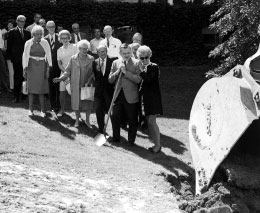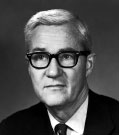In memoriam: Former DMS dean Carleton Chapman
Carleton Chapman, M.D., the dean of Dartmouth Medical School from 1966 to 1973, died on December 10, 2000. Chapman had played a historic role in the development of the School by leading the reestablishment of the M.D.-degree program.
When Chapman arrived in Hanover, he was already a nationally known cardiologist; he had been chief of cardiology at the University of Texas Southwestern Medical School and president of the American Heart Association. He was one of the early researchers who focused on "how the heart works in people," according to Andrew Wallace, M.D., also a former dean of DMS as well as a cardiologist.
Wallace says Chapman's papers on how the heart responds to exercise and stress still represent fundamental work in the field. Indeed, one study Chapman initiated at Southwestern on the "circulatory and pulmonary reaction to stress" is still, 40 years later, funded by the National Institutes of Health.
Intellectual breadth: Chapman also brought with him to DMS a breadth of intellectual interests; in fact, he almost became a professional organist.
As James Strickler, M.D., Chapman's successor as dean of DMS, remembers the story, Chapman was studying the organ overseas when he asked his teacher for a completely frank appraisal of his ability. The instructor told him, "You are very, very good, but you probably will not achieve the ranks of a truly great professional."
"With that," recalls Strickler, "he decided to change his career." And he went on to become, by any measure, a "truly great professional" in medicine. After graduating from Davidson College in 1936, he won a Rhodes Scholarship to study physiology at Oxford University, then earned both an M.D. and an M.P.H. at Harvard. He did his residency at Boston City Hospital and served in the U.S. Public Health Service from 1944 to 1946. After a stint on the faculty at the University of Minnesota, he was appointed a professor of medicine at Southwestern.
Goal: At DMS, Chapman's primary goal was to reestablish an M.D. program. He recruited Strickler to be associate dean in 1967, and the two developed an entire curriculum leading to the new degree. Strickler says that Chapman "was one of my mentors. He was an extraordinarily creative, brilliant man, who I think did a great deal for the Dartmouth Medical School in conceptualizing the degree program, in instituting some curriculum reforms, and persuading the Trustees to move ahead with the M.D. program."
The second-year curriculum that Chapman helped author, called Scientific Basis of Medicine, was "way ahead of its time and has been copied by many other medical schools," notes Wallace. He also points out that Chapman's prominence in national organizations—particularly as chair of the Association of American Medical Colleges' Council of Deans—was important in getting Dartmouth recognized as a new but serious M.D. program.
Chapman pioneered other innovations as dean. For one, he "espoused and articulated the role for a rural medical school," says Strickler. "Carleton felt strongly that a medical school— especially in a rural area—should be highly relevant to the practice of medicine in the region." He supported the Department of Community and Family Medicine and developed outreach programs and community-based clerkships for DMS students.
Vision: Richard Karl, M.D., who was recruited by Chapman as chair of surgery, remembers him as one of the major reasons why he came to DMS. "I was attracted to his vision and to his sense of leadership," says Karl. He notes that there were inevitable challenges in guiding an institution through such a period of change. People had "different expectations" about developing the clinical departments, Karl recalls. But he credits Chapman with giving him and the rest of the surgery department free rein to develop their program, as well as with understanding the requirements for maintaining firstrate clinical care.
Mahlon Hoagland, M.D., chaired biochemistry from 1967 to 1970, and he appreciated the support that Chapman gave him in implementing curricular innovations. Hoagland also knew Chapman as a neighbor in Thetford, Vt., and says that the two of them enjoyed "enthusiastic conversations about all sorts of subjects. He was very broadly educated. . . . I found him very stimulating to be around as a conversationalist. He enjoyed just relaxing and being outdoors."
During Chapman's years at the helm, the DMS faculty expanded from 60 to over 100, the student body doubled, sponsored research grew, and funds were raised for the construction of Vail and Chilcott, as well as for an addition to Dana Biomedical Library.
Innovations: Chapman left DMS in 1973, the same year that Dartmouth graduated its first M.D.'s since 1914. He went on to the presidency of the Commonwealth Fund in New York City. Margaret Mahoney, Chapman's successor in that post as well as a former DMS Overseer, says that his primary concern at the Commonwealth remained medical education. He was interested in the question of "How broad a person should you be before you become a medical student?" she says. He worked with medical schools, including DMS, to institute innovations in admissions policies and curriculum. Mahoney points out that the system of medical education has changed in the years since in ways that align with Chapman's vision.

|
|
|
Yet despite his focus on medical education, Chapman's eclectic background showed through. For example, while at the Commonwealth, he initiated funding for an English translation of The Digest of Justinian, a fundamental text in the legal field. Mahoney at first found this an idiosyncratic program for the healthcare- oriented Commonwealth Fund, but the completed translation was a great success for the organization as measured in worldwide sales. Mahoney also says that Chapman "championed" her appointment as the first woman president of a major foundation. "He was in medicine, but he was truly a renaissance person," she adds.
Inquiry: Chapman left the Commonwealth Fund in 1980 and focused on historical inquiry, with an appointment as a professor of the history of medicine at Albert Einstein College of Medicine and a visiting professorship at Johns Hopkins. In 1994, he published Order Out of Chaos, a biography of John Shaw Billings, a 19th-century physician, medical bibliographer, and scholar. Other titles to his credit include Physicians, Law, and Ethics and a history of DMS published in 1973, Dartmouth Medical School: The First 175 Years. He also wrote a feature for the Fall 1990 issue of Dartmouth Medicine, a literate discourse on the medical and historical aspects of his experience walking the length of Hadrian's Wall in Great Britain.
Even after he stepped down as DMS's dean, Chapman and his wife, Ruth, maintained a home in the Upper Valley, and they returned to the area to retire. When they moved into the Kendal retirement community in Hanover a few years ago, they donated to the facility an organ that Chapman had built.
-Jonathan Weisberg
If you would like to offer any feedback about this article, we would welcome getting your comments at DartMed@Dartmouth.edu.

 Carleton Chapman (right, and at
the far left above) oversaw several
major building projects and reinstituted
the M.D. program at DMS.
Carleton Chapman (right, and at
the far left above) oversaw several
major building projects and reinstituted
the M.D. program at DMS.